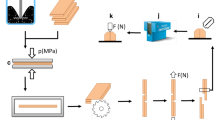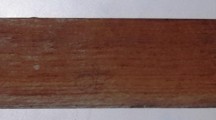Abstract
The objective of this study was to improve resistance of wood joints to higher humidity by means of heat or chemical treatment of beech wood prior to either welding or bonding with a UF adhesive. It was found that welded control and heat-treated wood had shear strengths of 8.6 and 8.8 N mm−2, respectively, whereas the specimens treated with citric acid had shear strengths of 6.6 and 9.9 N mm−2, respectively. However, this was lower than the shear strength of the UF bonded control and heat-treated wood (14.3 and 11.9 N mm−2, respectively).
Similar content being viewed by others
Avoid common mistakes on your manuscript.
1 Introduction
The welding of wood is a new technique which can be used to join two pieces of wood together, and to obtain environmentally friendly products, without the use of adhesives or any other connectors. The mechanical properties of welded wood are comparable to the mechanical properties of wood bonded with some non-structural wood adhesives (Gfeller et al. 2003; Leban et al. 2005). One of the main disadvantages of welded wood is its sensitivity to higher moisture. When the welded wood is exposed to a high humidity environment, water uptake and wetting begins at the edges of the joints leading finally to delamination of the joint. By varying the parameters of the welding procedure, the resistance of welded joints to elevated humidity can be improved to some extent. Additionally, thermal and chemical modifications of wood can reduce the effect of this shortcoming.
The exposure of wood to elevated temperatures (from 170 to 220 °C), in the absence of atmospheric oxygen, leads to changes in its structure and chemical composition, which can improve the dimensional stability of the wood and increase its resistance to decay. However, some mechanical properties of the heat-treated wood are degraded (Rep et al. 2010). The strength of welded heat-treated wood is about 50 % lower than the strength of non-heat-treated, natural wood. Increased rigidity and brittleness of wood cell walls have been detected in the interphase of the welded joint (Boonstra et al. 2006). Omrani et al. (2010) showed that pre-heating of the contact surfaces at temperatures higher than 85 °C causes changes that significantly reduce the shear strength of welded wood joints.
Wood can also be chemically modified in order to reduce the adsorption of moisture, shrinkage, swelling, and the tendency to photo- and biological degradation. Modification of beech wood with citric acid, due to reaction with the chemical components of the wood, increases its dimensional stability and biological resistance (Despot et al. 2008), and can, to some degree, strengthen the fibres. Citric acid also improves adhesion in the manufacture of wood-based mouldings.
The objective of this study was to establish optimal welding parameters for satisfactorily joining of control (untreated) or heat-treated beech wood. Solutions of citric acid were applied to the contact surfaces in order to improve the shear strength of joined specimens and their resistance to elevated humidity. Specimens bonded with urea–formaldehyde (UF) adhesive were also prepared for comparison.
2 Materials and methods
2.1 Heat treatment and preparation of the beech wood
Heat treatment of beech wood (Fagus sylvatica L.) was performed in an inert atmosphere with an intact vacuum (Rep et al. 2010) for 3 h at a temperature of 210 °C. Before and after the treatment, the wood was conditioned for 12 h at a temperature of 103 ± 2 °C. Full scale industrial samples were then cut into smaller specimens of size 20 × 22 × 200 mm3 for welding and 5 × 130 × 300 mm3 for bonding with UF adhesive.
2.2 Chemical treatment of the wood with citric acid
Two (10 and 20 %) water solutions of citric acid were prepared and two application methods were used (coating and vacuum impregnation). The prepared solutions were then applied to the freshly planed wood surface (intended for welding) with a brush at a spreading rate of approximately 125 g m−2. Vacuum impregnation of the specimens with acid solutions was carried out in a desiccator, with 10 min of air suction, and left immersed for 1 h at atmospheric pressure. The specimens were then conditioned in a standard climate with 65 % RH, at 20 °C, so that they reached equilibrium moisture content.
2.3 Preparation of linear welded specimens
A mechanical welding machine KLN Ultraschall LVW-2261 (Epinal, France) was used to weld the two pieces of wood together by linear vibrational movement of one wood surface relative to the other. The amplitude was 2 mm at a frequency of 150 Hz. Other welding parameters are shown in Table 1. The welding parameters were the same for all specimens within either control groups or heat-treated groups, regardless of citric acid treatment. After the vibration process had been stopped, the clamping pressure was still briefly maintained until solidification of the bond had occurred. The welded samples were conditioned for 1 week at 20 °C and 65 % RH prior to testing.
2.4 Preparation of UF bonded specimens
Two beech wood lamellas were bonded together according to EN 205 (2003) by means of conventional hot-pressing, using a commercial UF adhesive Lendur 200 (manufacturer Nafta-Petrochem d.o.o., Lendava). Prior to the bonding, the lamellas were planed in order to ensure smooth and flat radial surfaces. The UF adhesive mixture was applied to one surface at a rate of 200 g m−2 by means of a roller. The specific press pressure was 1.8 MPa, the press temperature was 105 °C, and the pressing time was 7 min.
2.5 Preparation and testing of the shear specimens
Shear specimens with a width of 20 mm and a length of 150 mm were cut from the welded and UF bonded samples and, after corresponding pre-treatment according to EN 12765 (2001), were tested with a Zwick/Roell Z005 universal testing machine according to the standard EN 205.
3 Results and discussion
The shear strength of joints decreased with the severity of the pre-treatment according to EN 12765 (Table 2). The best shear strength of the joints was observed in the case of those specimens, which were conditioned under standard climate conditions (first pre-treatment). The second (immersion in water) and third (immersion in hot water) pre-treatments resulted in a significant drop in the shear strength. In general, the specimens of welded heat-treated beech wood showed higher shear strength of the joint than the specimens of the control beech wood. This can be attributed to the better dimensional stability of the heat-treated wood in a moist environment, which implies lower internal stresses on the joint. This also applies to UF bonded specimens. Both control and heat-treated specimens exceeded standard requirements for pre-treatment 1 (dry conditions), but only heat-treated UF bonded specimens exceeded standard requirements for pre-treatment 2 and 3 (wet conditions). This can be explained by lower internal stresses in the joint due to better dimensional stability of the heat-treated wood in moist conditions. In comparison to the UF bonded specimens, the welded specimens reached lower shear strength values. After the fourth pre-treatment (immersion in boiling water), all the joints fell apart. Application of a citric acid solution to the control and heat-treated beech wood did neither improve the shear strength of the joints nor the resistance to high humidity, irrespective of the application technique used (coating/vacuum impregnation) and acid concentration.
4 Conclusion
The welding of control and heat-treated beech wood appeared to be a possible joining technique without the use of an adhesive, but the resulting shear strength of the joints was lower than in the case of UF bonded specimens. It was found that the joints of the welded heat-treated beech wood are less susceptible to a moist environment as compared to the welded control beech wood. The application of citric acid solution did not significantly improve the shear strength of the welded joints and their resistance to high humidity. The welded joints of the control and heat-treated wood did not reach the values of tensile shear strength required according to EN 12765.
References
Boonstra M, Pizzi A, Ganne-Chedeville C, Properzi M, Leban JM (2006) Vibrational welding of heat-treated wood. J Adhes Sci Technol 20(4):359–369
Despot R, Hasan M, Jug M, Šefc B (2008) Biological durability of wood modified by citric acid. Drvna Industrija 59(2):55–59
EN 12765 (2001) Classification of thermosetting wood adhesives for non-structural applications
EN 205 (2003) Adhesives—Wood adhesives for non-structural applications—Determination of tensile shear strength of lap joints
Gfeller B, Zanetti M, Properzi M, Pizzi A, Pichelin F, Lehmann M, Delmotte L (2003) Wood bonding by vibrational welding. J Adhes Sci Technol 17(11):1573–1589
Leban JM, Pizzi A, Properzi M, Pichelin F, Gelhaye P, Rose C (2005) Wood welding: a challenging alternative to conventional wood gluing. Scand J for Res 20:534–538
Omrani P, Mansouri HR, Pizzi A, Masson E (2010) Influence of grain direction and pre-heating on linear wood welding. Eur J Wood Prod 68:113–114
Rep G, Humar M, Pohleven F (2010) Resistance of thermo-vacuum modified wood against wood pests. First Serbian forestry congress, Faculty of forestry, Belgrade University. Serbia, pp 1564–1570. Accessed 11–13 Nov 2010
Acknowledgments
The authors gratefully acknowledge the financial support of the Slovenian Research Agency within the framework of the research program P4-0015.
Author information
Authors and Affiliations
Corresponding author
Rights and permissions
About this article
Cite this article
Zigon, J., Pizzi, A., Zhang, H. et al. The influence of heat and chemical treatments of beech wood on the shear strength of welded and UF bonded specimens. Eur. J. Wood Prod. 73, 685–687 (2015). https://doi.org/10.1007/s00107-015-0930-0
Received:
Published:
Issue Date:
DOI: https://doi.org/10.1007/s00107-015-0930-0




